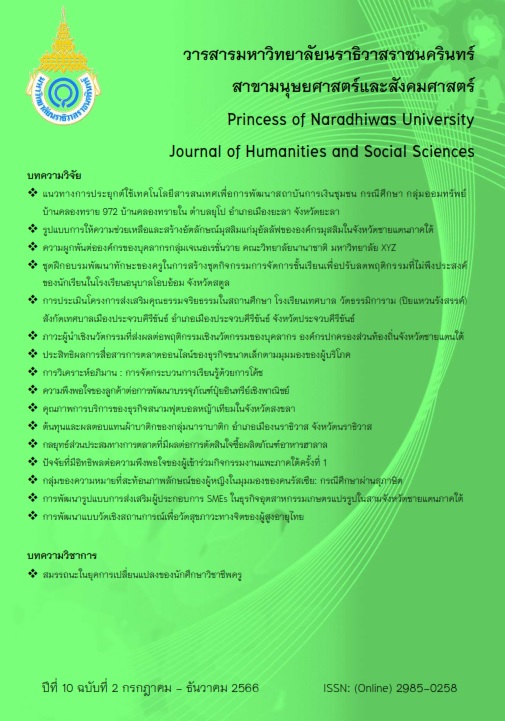The development of a model to promote SMEs entrepreneurs in the agro- processing industry in three southern border provinces
Main Article Content
Abstract
This qualitative research regarding on entrepreneur promotion has the objectives as follows: 1) To study the components of the SMEs promotion model. 2) To develop a promotion model for SMEs entrepreneurs. 3) To create a guideline implementing the promotion model for SMEs entrepreneurs in the agro-processing industry in three southern border provinces. The Delphi method was used including 20 experts from 5 provinces purposive sampling with purposive sampling based on specifying the provincial boundaries, namely Yala, Pattani, Narathiwat, Phatthalung and Songkhla. The expert groups consisted of industrial experts, The Federation of Thai Industries Chamber of Commerce and SMEs entrepreneurs. Data analysis involved three rounds: Round 1 analyzed the content from expert opinions, focusing on identifying recurring issues. In Rounds 2 and 3, the analysis included the following steps: 1) Calculating the median values above 3.50. 2) Calculating the difference between the mode and the median. 3) Calculating the interquartile range, which should be less than 1.50. The research findings revealed the promotion model for SMEs entrepreneurs consists of 8 main components and 43 sub-components Furthermore, the study is able to develop a promotion model for SMEs and create a guideline implementing the model in the agro-processing industry in three southern border provinces.
Article Details

This work is licensed under a Creative Commons Attribution-NonCommercial-NoDerivatives 4.0 International License.
References
กระทรวงแรงงาน. (2563). สถิติแรงงานประจำปี2562. กรุงเทพฯ: สำนักงานปลัดกระทรวงแรงงาน.
กัลยรัตน์ พินิจจันทร์, ดุษฎี นาคเรือง, วัชระ ขาวสังข์, ปิยะดา มณีนิล, ปวีณา เจะอารง, อับดุลเราะห์มาน สาและ, และภูริชาติ พรหมเต็ม. (2561). การพัฒนาศักยภาพกระบวนการผลิตและการตลาดของกลุ่มแปรรูปผลิตภัณฑ์จากปลาน้ำจืดบ้านตา พะเยาอำเภอธารโต จังหวัดยะลา. วารสารการบัญชีและการจัดการ มหาวิทยาลัยมหาสารคาม, 12( 4), 67-81.
โซเฟีย แวหะมะ. (2561). การวิเคราะห์ศักยภาพของผู้ประกอบการรับซื้อผลผลิตยางพารารายย่อยเพื่อกำหนดกลยุทธ์ในการพัฒนาการค้าในพื้นที่สามจังหวัดชายแดนใต้. วารสารวิทยบริการ มหาวิทยาลัยสงขลานครินทร์, 29(3), 102-116.
ธิติยา ทองเกิน. (2564). การพัฒนาศักยภาพการประกอบธุรกิจชุมชนและการพึ่งพาอาศัยบึงบอระเพ็ดอย่างยั่งยืน. วารสารวิชาการเครือข่ายบัณฑิตศึกษา มหาวิทยาลัยราชภัฏภาคเหนือ, 11(2), 45-60.
นฤมล ดำอ่อน. (2562). รูปแบบการจัดการเครือข่ายชุมชนเพื่อความมั่นคงทางอาหาร (วิทยานิพนธ์ปรัชญาดุษฎีบัณฑิต). มหาวิทยาลัยศิลปากร, กรงเทพฯ.
พุทธิฉัตร ปัญญาประชุม. (2559). ผลกระทบของสภาพแวดล้อมการทำงานต่อประสิทธิภาพการทำงานของพนักงานในอุตสาหกรรมยานยนต์ เขตอุตสาหกรรมนิคมแหลมฉบัง (วิทยานิพนธ์ บริหารธุรกิจมหาบัณฑิต). มหาวิทยาลัยเกษตรศาสตร์, กรุงเทพฯ.
วิวัฒน์ จันทร์กิ่งทอง, ยรรยง คชรัตน์, นธี เหมมันต์, จุฑามาศ พรหมมนตรี, นิศาชล สกุลชาญณรงค์, และฐานันท์ ตั้งรุจิกุล. (2562). การพัฒนาบรรจุภัณฑ์และป้ายฉลากเครื่องแกงตำมือ บ้านทุ่งชุมพลพัฒนา ตำบลลานข่อย อำเภอป่าพะยอม จังหวัดพัทลุง. การประชุมหาดใหญ่วิชาการระดับชาติและนานาชาติ ครั้งที่ 9 (หน้า 1491-1505). สงขลา: มหาวิทยาลัยหาดใหญ่.
สำนักงานสภาพัฒนาการเศรษฐกิจและสังคมแห่งชาติ. (2560). แผนพัฒนาเศรษฐกิจและสังคมแห่งชาติ ฉบับที่ 12. กรุงเทพฯ: สำนักนโยบายและยุทธศาสตร์ สำนักงานปลัดกระทรวงศึกษาธิการ กระทรวงศึกษาธิการ
สำนักโฆษก สำนักเลขาธิการนายกรัฐมนตรี. (2560). Thailand 4.0 ขับเคลื่อนอนาคตสู่ความมั่นคง มั่งคั่ง ยั่งยืน. วารสารไทยคู่ฟ้า, 33(4), 3-17.
อาชวิน ใจแก้ว. (2561). การบูรณาการศักยภาพการผลิตเชิงกลยุทธ์ที่มีผลต่อความได้เปรียบในการแข่งขันของคลัสเตอร์วิสาหกิจกลุ่มล้านนาในประเทศไทย (วิทยานิพนธ์ปริญญาดุษฎีบัณฑิต). มหาวิทยาลัยราชภัฎลำปาง, กรุงเทพฯ.
เอกกมล เอี่ยมศรี. (2556). การบริหารงานการเงิน (Financial Management) . สืบค้นจาก https:// eIamsri.wordpress.com
เอกชัย คุปตาวาทิน, พัลลภ พรมสาเพ็ชร, วาสนา ช่อมะลิ, และทายวุฒิ โพธ์ทองแสงอรุณ. (2561). แนวทางการลดต้นทุนโลจิสติกส์ กรณีศึกษา เกษตรผู้ปลูกมันสำปะหลัง ตำบลบ้านค้อ อำเภอเมือง จังหวัดขอนแก่น. วารสารมนุษยศาสตร์และสังคมศาสตร์, 9(2), 48-74.
Gamal, N. L., Taneo, S. Y. M., & Halim, L. (2018). Job satisfaction as a mediation variable in the relationship between work safety and health (K3) and work environment to employee performance. Journal of Applied Management, 16(3), 486-493.
Morris, M. H., Kuratko, D. F., & Covin, J. G. (2008). Corporate Entrepreneurship & Innovation, Entrepreneurial Development within Organizations (2nded). Thomson: South-Western.
Pratt, M. K., & Tucci, L. (2020). SWOT analysis strengths, weaknesses, opportunities and threats analysis. Retrieved from https://searchcio.Techtarget.com/definition/SWOT-analysis-strengths -weaknesses-opportunities-and-threats-analysis
Riyanto, S., Sutrisno, A., & Ali, H. (2017). The Impact of working motivation and working environment on employees performance in Indonesia stock exchange. International Review of Management and Marketing, 7(3), 342-348.
Sujarwo, E., CicihRatnasih, & Sodikin, A. (2018). The effect of organizational culture and environmental work on employee performance through organization commitment PT. Ciwangi Berlian Motors. International Journal of Business and Applied Social Science, 4(5), 14-27.
Wertime, K., & Fenwick, I. (2008). DigiMarketing, the Essential Guide to New Media & Digital Marketing (1st ed.). New Jersey: Wiley & Son.


